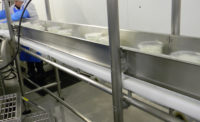
Real Mex's new completely retrofitted state-of-the-art plant quadrupled the company's production capacity.
Could it be a lucky penny? Or perhaps a rabbit’s foot? Whatever the reason, it’s clear that executives at Real Mex Foods, Buena Park, Calif., are enjoying a streak of good luck. After all, the company: has seen exponential growth (this year it’s on pace to grow sales 20 percent); is positioned in a rapidly growing niche; landed an opportunistic deal on a completely retro-fitted, state-of-the-art plant; and is launching a multi-serve frozen line at a time when consumers are looking for restaurant-quality meals in the freezercase.
While it might be tempting to chalk all this success up to good fortune, there is much more to this company’s success than luck - smart business decisions have defined Real Mex’s strategy since the early 1970s. More than 30 years ago, it began as a Pasadena, Calif., commissary supplying Acapulco restaurants. Today, it continues to supply more than 200 restaurants as the distribution branch of Real Mex Restaurants, Cypress, Calif., including Chevy’s, El Torito and Acapulco restaurant concepts located in Arizona, California, Nevada, Oregon and Washington.
In addition, Real Mex Foods has branched into broader frozen foods processing for foodservice, co-pack and retail channels serving clients such as Sysco Distributors, El Pollo Loco, Carl’s Jr.-Green Burrito, Albertson’s and U.S. Foods.
President Carlos Angulo recalls the turning point.
“Around 2003, we decided to do an analysis on the manufacturing side of our business because we were only manufacturing for our own restaurants … And that was really when we decided that we would begin selling to customers other than our own restaurants,” he says. “So, what simultaneously started to happen while we were growing on the distribution side, we made the decision to keep a manufacturing plant and also focus on outside sales. In 2003 we did about $3.8 million in outside sales. … This year we will hit about $45 million.”
This decision - to be both distributor and processor to outside clients - has led Real Mex’s sales to blossom to an expected $155 million this year.
Just lucky? Hardly, Real Mex also has done well with its distribution and co-packing businesses, which now account for 45 percent and 15 percent of sales, respectively (R&D accounts for 40 percent).
“Being able to combine manufacturing and distribution is a very unique thing that makes us aggressively priced,” Angulo adds.
This fact has not gone unnoticed. Last year saw Real Mex’s outside sales grow by 44 percent and early 2008 brought another milestone for the company.
In February, Real Mex closed its 32,000-square-foot manufacturing plant in Santa Fe Springs, Calif., and moved into a 100,000-square-foot space in Vernon, Calif.
“The city of Vernon and a developer came to us and proposed a deal where we got a 100,000-square-foot building retrofitted to a state-of-the-art USDA manufacturing plant,” Angulo explains. “It was an opportunistic deal. … They got us into 100,000 square feet at the cost that we would have gotten a build-to-suit 65,000-square-foot building.”
Food safety also was a major priority for Real Mex in building out the new plant. The company built an in-house lab and hired a complete quality assurance team. Other food safety precautions include a triple boiler system, floor foamers, centralized sanitation system, in-house chlorination system for vegetables and a full quality assurance staff.
Again, fortune seemed to be smiling on the company. The developer invested $10 million in the build out, while Real Mex spent about $4 million on equipment. The completely refurbished plant quadrupled the company’s previous capacity and allowed it to more than double the number of kettles, tumble chillers and blast freezers.
“Always in the past we had capacity issues. So even though we grew, we grew very cautiously,” Angulo says. “In the new plant … we could grow an estimated five times.”
The extra space allows Real Mex to focus on expansion.
“Now we are going to begin marketing and growing at a faster pace,?” Angulo adds. “We want to eventually fill out the company in to a three-year plan of $250 million in sales.?”
That growth likely will include adding an East Coast processing plant in the next year or two as well. A small East Coast contingent of Real Mex restaurants is served by local distribution partners.
“There is a lot of demand ... to have procuct available manufactured in the East,” Angulo says.
This demand will no doubt continue to grow as Real Mex takes on another venture. This October the company launched its first frozen multi-serve entrée line at grocery and club stores. Currently available only on the West Coast, Angulo says Real Mex eventually plans to distribute the line nationally.
“We’re positioned in the meals for two category and we see a huge opportunity there,” he says.
And, here, Real Mex isn’t leaving anything up to luck. New products feature the authentic flavors and high-quality ingredients the company favors in its foodservice products.
“We turned to more authentic food,” explains Angulo. “We produce products that you can see the ingredients in the burrito, tamale or enchilada. You can taste every unique flavor. We hope to create craveable signature dishes just like our restaurants.”

Angulo
Fast Facts
Real Mex FoodsLocation:Buena Park, Calif.
Top executive(s):Carlos Angulo, president; Ignacio Varela, executive chef and senior vice president of sales and manufacturing
Founded:1954
Annual sales:Approximately $155 million
Primary products:Frozen tamales, chile, beans, flautas, burritos, rice, enchiladas, sauces, dressings, soups and brownies
Brands:Real Mex
Channels served: Foodservice, co-packing, retail
Distribution:West Coast, Southwest
On the Web:www.realmexfoods.com
